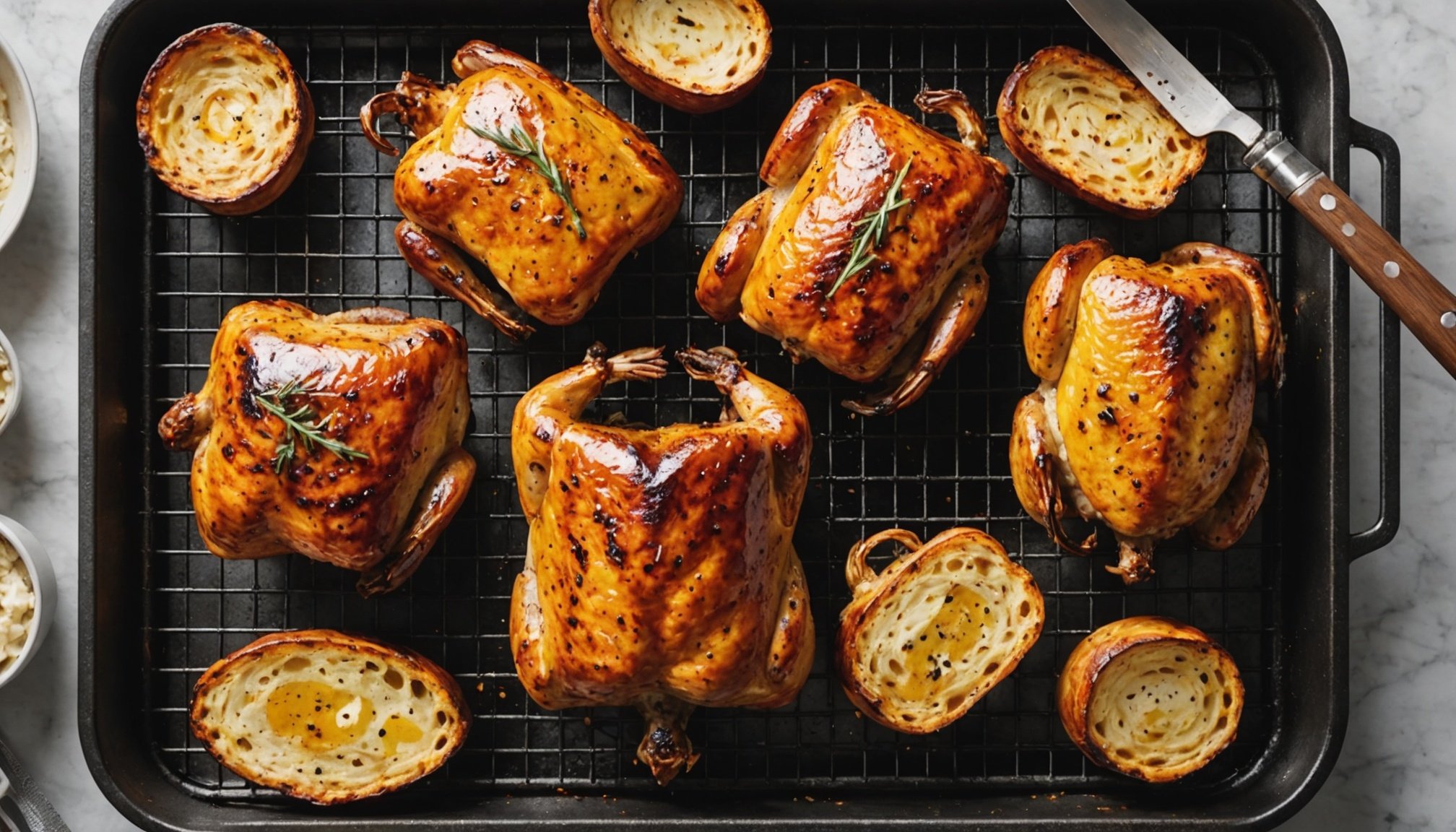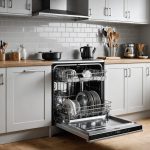Understanding Roasting Racks
Roasting racks not only elevate meat but also crucially impact cooking results. To begin, let’s explore roasting rack types. Flat racks are typical, offering a stable surface for even cooking, while V-shaped racks cradle meat snugly, ideal for poultry or roasts. Lover of diverse cuisine? Adjustable racks provide flexibility for different sized cuts.
The benefits of using a roasting rack extend beyond just supporting food. They lift meat above dripping fats, promoting healthier cooking and air circulation for an even roast — no more soggy bottoms! This crucial elevation aids in achieving crispy skin and uniformly cooked interiors, ideal for those demanding perfection.
Also to see : Brilliant Techniques Revealed: Comprehensive Handbook for Polishing Your Stainless Steel Gas Cooktop
Furthermore, roasting racks simplify cleanup. The raised position means less contact with juices and oils, reducing burnt-on residue. Many racks are dishwasher-safe, but even with handwashing, the task becomes more manageable. By limiting the mess in your roasting pan, you save both time and effort.
Considering these factors, a roasting rack becomes an invaluable tool in the kitchen. Whether looking to make your holiday turkey a star or simply wanting to enhance your everyday cooking, understanding the nuances of different racks can significantly elevate your culinary endeavors.
Also read : The Ultimate Guide: Choosing the Ideal Rice Cooker Size to Meet Your Large Family’s Culinary Needs!
Materials and Their Impact on Performance
The choice of roasting rack materials significantly influences both heat distribution and durability in the kitchen. The most common options include stainless steel and non-stick coatings, each with distinct properties.
Stainless steel racks are renowned for their robustness and even heat distribution. This material resists warping under high temperatures and remains rust-free, delivering long-lasting performance. Notably, stainless steel doesn’t react with acidic foods, preserving the integrity of flavours.
Conversely, non-stick racks offer easy cleaning thanks to their coated surface, reducing food residue adherence. They are perfect for quick clean-ups but may wear over time, especially if abrasive tools are used.
When comparing these materials, stainless steel excels in durability, making it ideal for frequent users. Non-stick racks, while convenient, require careful handling to maintain their performance. Each material type impacts cooking outcomes by either enhancing heat distribution or streamlining post-roast cleanup.
Both types influence the longevity and cooking results of your roasting rack, so it’s essential to choose based on how often and intensely you plan to use your rack. Selecting the right material can improve overall cooking results, making each roasting session effective and enjoyable.
Key Features to Consider
When selecting a roasting rack, assessing key features can significantly influence cooking results and overall user experience. One critical aspect is adjustable racks, offering flexibility for diverse cooking needs. They allow you to manage the height according to the size of your meat or vegetables, ensuring even cooking.
Consider the size and shape of a rack. While compact racks suit smaller roasts or intimate gatherings, larger racks accommodate grand meals and expansions. Selecting the correct size prevents overcrowding, which can compromise roasting quality.
Additional features like legs provide stability and allow heat to circulate evenly under the food. Opt for those with non-slip designs to ensure safety and stability during cooking. Some models feature removable parts, simplifying maintenance and cleaning efforts without sacrificing utility.
Selecting a roasting rack with the right features enhances your cooking experience, offering convenience and optimising performance. Prioritise features based on your cooking habits and desired results for stress-free roasting. With awareness of your specific needs, the right rack can elevate your culinary creations, allowing you to achieve professional-grade cooking.
Optimal Usage Tips
To achieve perfect cooking results, understanding roasting rack usage is vital. Proficiency in various cooking techniques enhances flavour and promotes even cooking for meats and vegetables.
For meats, place them fat side up on the rack, allowing juices to baste the meat naturally. This technique keeps the meat moist and tender. When roasting vegetables, cut them uniformly to ensure even cooking. Spread them in a single layer to maximise surface contact with the rack, allowing optimal crispness.
Enhancing flavours involves seasoning directly before roasting. Experiment with marinades or rubs for flavour infusion. Herbs and spices added during the last cooking stages can prevent burning while enhancing aroma and taste.
When seeking convenience, avoid common mistakes like overcrowding, which hinders heat circulation and results in uneven cooking. Instead, provide space between items on the rack.
Consider these tips a guide to optimising your cooking techniques and overall culinary prowess. By mastering these methods, you accentuate natural flavours while achieving exquisite roasting results effortlessly. Being diligent with these techniques empowers cooks to deliver remarkable dishes, attracting admiration for their enhancing flavours.
Maintenance and Care
Proper roasting rack maintenance is essential for preserving the quality and extending the lifespan of your kitchen asset. Pay attention to specific cleaning methods, which vary depending on your rack’s material.
For stainless steel racks, a soft sponge with warm, soapy water effectively removes food residues without scratching the surface. This material tolerates dishwasher use but ensure adequate spacing to prevent damage from other items.
When maintaining non-stick racks, avoid abrasive scrubbers to protect the coating. Gentle handwashing is recommended, coupled with immediate drying to curb moisture-induced wear. To uphold their performance, steer clear of metal utensils which may scratch the surface.
Storage plays a pivotal role in prolonging a roasting rack’s longevity. Store racks in a dry area, and if space permits, hang them to prevent unnecessary stacking pressure that can lead to deformation. Implement simple care routines regularly to safeguard your investment.
By incorporating these cleaning tips and maintenance habits, you can ensure your rack performs optimally whenever needed. Proper care not only enhances usability but protects against wear, ensuring a clean slate for your delicious culinary creations every time.
Comparing Popular Roasting Racks
Selecting the ideal roasting rack involves understanding roasting rack reviews and making informed product comparisons.
Top-rated Roasting Racks on the Market
Among the most acclaimed racks, brands like KitchenAid and Cuisinart consistently receive praise for their durability and versatility. Their models often feature stainless steel racks, ensuring robust and even heat distribution.
Budget-friendly Options
For those seeking quality without breaking the bank, budget-friendly racks from names like Wilton offer excellent value. These non-stick racks simplify cleanup, though they may require more cautious handling to avoid wear.
High-end Choices for Serious Cooks
Serious cooks may gravitate towards high-end options like the All-Clad roasting racks. These models often possess additional features—such as adjustable racks and non-slip designs—enhancing both usability and cooking results, justifying their premium price.
Making an informed decision requires assessing these attributes against personal cooking needs. Whether prioritising cost, durability, or performance, the variety of options available enables cooks to find the perfect fit for their culinary ambitions. By understanding the market landscape, you can confidently select a roasting rack that aligns with your expectations and enhances your kitchen experience.
Frequently Asked Questions
When it comes to roasting rack FAQ, common concerns often arise among home cooks. One frequently asked question is: “What size roasting rack should I use?” Precision matters here—choose a rack that accommodates your pan without contact, enabling proper air circulation and even heat distribution.
Another popular question involves maintaining rack integrity: “How do I prevent my stainless steel rack from rusting?” The answer lies in diligent drying post-wash and ensuring the rack is stored in a dry environment. This prevents moisture accumulation, a common cause of rust.
For those concerned with troubleshooting issues like food sticking on non-stick racks, avoid using metal utensils that can damage the coating. Instead, opt for silicone or plastic tools while handling food on non-stick surfaces.
“How does a rack influence cooking results?” This revolves around even cooking and fat drainage, promoting healthier meals. Racks elevate food, allowing drippings to separate, which is crucial for roasting fatty meats to perfection.
Drawing on expert insights, it’s essential to select a rack tailored to your specific cooking needs. Whether you seek versatility with an adjustable feature or robust durability with stainless steel, the right rack significantly enhances culinary results.



